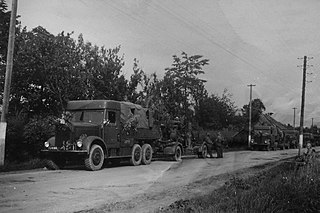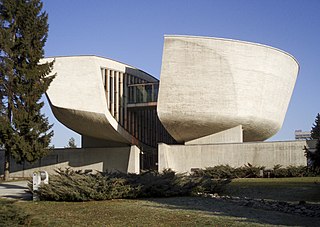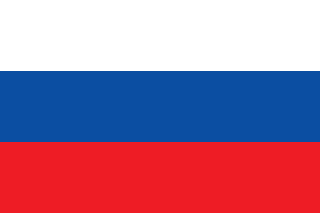 W
WThe Slovak National Uprising was an armed insurrection organized by the Slovak resistance movement during World War II. This resistance movement was represented mainly by the members of the Democratic Party, but also by social democrats and Communists, albeit on a smaller scale. It was launched on 29 August 1944 from Banská Bystrica in an attempt to resist German troops that had occupied Slovak territory and to overthrow the collaborationist government of Jozef Tiso. Although the resistance was largely defeated by German forces, guerrilla operations continued until the Red Army, Czechoslovak Army and Romanian Army liberated Fascist Slovakia in 1945.
 W
WThe Armored train Hurban was an armored train used during World War II, during the Slovak National Uprising. The Hurban was constructed on September 25, 1944, in the Railway Manufactory in Zvolen, Slovakia, and was the last armored train used in the Slovak National Uprising. A replica is displayed as a monument in a park next to the castle in Zvolen, and an original preserved machine gun carriage is at the Museum of the Slovak National Uprising in Banská Bystrica.
 W
WThe Armored train Štefánik was a military train used during World War II in Slovakia.
 W
WBanská Bystrica is a city in central Slovakia located on the Hron River in a long and wide valley encircled by the mountain chains of the Low Tatras, the Veľká Fatra, and the Kremnica Mountains. With 76 000 inhabitants, Banská Bystrica is the sixth most populous municipality in Slovakia. The present town was founded by German settlers, however it was built upon a former Slavic settlement. It obtained the municipal privileges of a free royal town of the Kingdom of Hungary in 1255. The copper mining town acquired its present picturesque look in the Late Middle Ages when the prosperous burghers built its central churches, mansions, and fortifications. It is the capital of the kraj and the okres. It is also the home of Matej Bel University. As a historical city with an easy access to the surrounding mountains, Banská Bystrica is a popular winter and summer tourist destination.
 W
WJán Golian was a Slovak Brigade General who became famous as one of the main organizers and the commander of the insurrectionist 1st Czechoslovak Army in Slovakia during the Slovak National Uprising against the Nazis.
 W
WThe Hlinka Guard was the militia maintained by the Slovak People's Party in the period from 1938 to 1945; it was named after Andrej Hlinka.
 W
WThe 1st Czechoslovak Partisan Brigade of Jan Žižka, initially known as Ušiak-Murzin Unit, was the largest partisan unit in the Protectorate of Bohemia and Moravia during the German occupation of Czechoslovakia. After its core membership of Soviet-trained paratroopers were dropped into Slovakia in August 1944, the brigade crossed into Moravia and began operations in earnest at the end of 1944. Its focus was guerrilla warfare, especially sabotage and intelligence gathering.
 W
WKalište was a former village in the Banská Bystrica district in the Slovak Republic. It was destroyed by the Nazis during the Slovak National Uprising in Second World War. Its remains are now managed by the Museum of the Slovak National Uprising.
 W
WThe Kremnička and Nemecká massacres were a series of massacres committed between 5 November 1944 and 19 February 1945 in Kremnička and Nemecká, Slovakia by the Hlinka Guard Emergency Divisions and Einsatzkommando 14 following the suppression of the Slovak National Uprising. During the uprising, many Jews fled to Banská Bystrica, a partisan stronghold; when the town fell, Jews, actual or suspected Slovak partisans, and Romani people captured during roundups were temporarily held in the town's jail. The victims were then trucked to the murder sites at Kremnička and Nemecká, where they were shot. The majority of the 747 people shot at Kremnička were Jewish. Exact figures are not known for the Nemecká massacres, because the bodies were burned, but historians estimate a death toll of around 900, of whom most of the known victims were Jewish or Romani.
 W
WJozef Lettrich was a Slovak writer and politician.
 W
WMuseum of the Slovak National Uprising is a museum in Banská Bystrica that commemorates the Slovak National Uprising, an antifascist revolt during World War II.
 W
WSliač Airport or, historically, Letisko Tri Duby is an international airport in central Slovakia situated between the towns of Zvolen and Banská Bystrica and near the spa town of Sliač. The airport has one runway which is 2,400 m long (18/36). The airport is used by the military as well as commercially for civilian flights.
 W
WThe Slovak Insurgent Air Force was an Allied air unit which fought against Axis forces in Slovakia and participated in Slovak National Uprising in August-October 1944.
 W
WThe (First) Slovak Republic, otherwise known as the Slovak State, was a partially-recognized client state of Nazi Germany which existed between 14 March 1939 and 4 April 1945. The Slovak part of Czechoslovakia declared independence with German support one day before the German occupation of Bohemia and Moravia. The Slovak Republic controlled the majority of the territory of present-day Slovakia but without its current southern parts, which were ceded by Czechoslovakia to Hungary in 1938. It was the first time in history that Slovakia had been a formally independent state.
 W
WRudolf Viest was a Slovak military leader, member of the Czechoslovak government in exile, member of the Slovak National Council and the commander of the 1st Czechoslovak army during the Slovak National Uprising. He was the Slovak with the highest military function and the only Slovak general during the interwar period in the first Czechoslovak Republic.